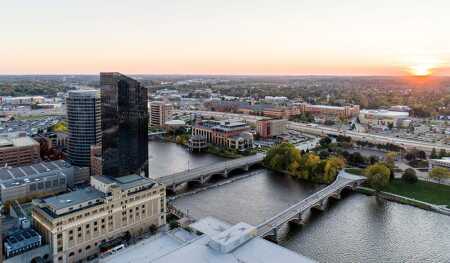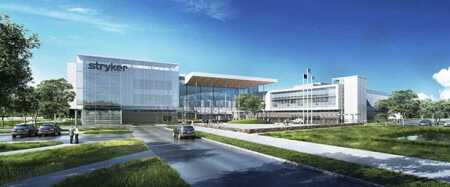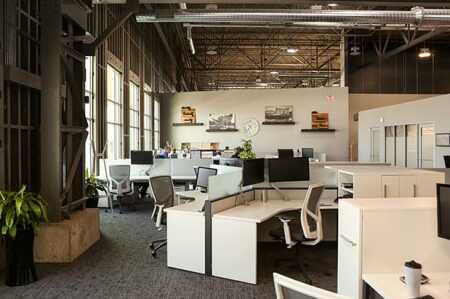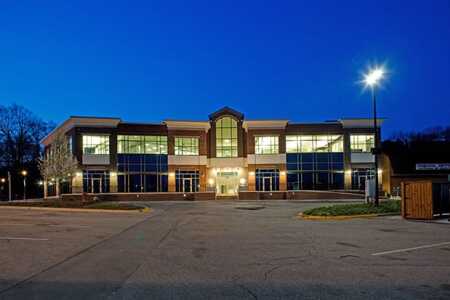Western Michigan—which includes Grand Rapids, Muskegon, Holland, and Kalamazoo—has a long history in agribusiness. The area is the nation’s top grower of blueberries, and since 1869, Kalamazoo-based A.M. Todd has been a global leader in natural mint extracts for the oral care, confectionary, food, and beverage industries. The region also leads the state in poultry, dairy, squash, and carrot production.
But the region also has rapidly growing life sciences clusters specializing in everything from medical equipment and surgical devices from Kalamazoo-based Stryker Corporation to over-the-counter health care supplies and infant formula from Allegan-based Perrigo Company. It also has a robust manufacturing sector, focused on metals, plastics, biopharmaceuticals, and automotive products, as well as office furniture, including three big names in furniture manufacturing—Herman Miller, Steelcase, and Haworth.
Sustainability
With a population of nearly 200,000, Grand Rapids, the second-largest city in Michigan, has been focused on sustainability for nearly 25 years. In 2007, it was the first U.S. city recognized by the United Nations as a Regional Centre of Expertise for Education for Sustainable Development. According to the U.S. Green Building Council, Grand Rapids has more than 450 buildings certified under the Leadership in Energy and Environmental Design (LEED) program, including the world’s first LEED Gold art museum (the Grand Rapids Art Museum) and the world’s first LEED-certified transit station (the Rapid Central Station, offering bus service).
“It is more than just building materials and land use,” says Rick Chapla, vice president for strategic initiatives at the Right Place, an economic development organization serving western Michigan. “It’s about maintaining the health and livability of our city in order to attract visitors, residents, and industries.”
Situated on the Grand River, the city of Grand Rapids, along with nonprofit Grand Rapids Whitewater, is coordinating a $35 million project, Return the Rapids to the Grand, aimed at restoring the city’s namesake, which disappeared as a result of a series of dams built nearly a century ago. The multiyear project, still in the planning stages, proposes to improve natural habitats, water quality, and aesthetics, as well as create more recreational opportunities, restore wetlands, reconnect floodplains, and enhance use of the city’s riverfront.
“Providing a great quality of life keeps us competitive when people and companies look to relocate to the area,” notes Chapla. “The Grand River is our largest natural asset and plays an increasingly important role in the city’s future.”
Opportunities for brownfield redevelopment are another aspect of sustainability. In Portage, just outside Kalamazoo, global medical technology company Stryker is building a $154 million, 435,000-square-foot (40,000 sq m) state-of-the-art research and development facility designed by Kalamazoo-based TowerPinkster and St. Louis–based HOK. Construction of the facility, situated on 75 acres (30 ha), began in May 2017, with construction development being overseen by the Christman Company of Grand Rapids. The project is expected to be completed in 2019.
“Stryker has had a long history in the Kalamazoo area, and it is meaningful that they continue to invest here, sustaining jobs and creating new ones,” says Jill Bland, managing partner of Southwest Michigan First, an organization of privately funded economic development advisers.
Quality of Life
One reason Stryker continues to invest in the area is the high quality of life—from recreational opportunities to affordable housing—that it offers the company’s nearly 3,000 local employees. “We are very conscious of what it takes to attract and keep talent here,” says Bland. The community is focused on providing residents with engaging neighborhoods offering family-friendly amenities and great public schools.
A high quality of life also helps the area retain the talent that comes from local universities, such as Western Michigan University in Kalamazoo, and Kalamazoo College.
“We are specifically planning for their needs,” says Bland. “They want to live in or near the downtown; they’re looking for walkability, access to bike paths, and ample public transportation.” The community is finding ways to improve connectivity throughout the city and campuses—creating more bike lanes, improving bus routes, and considering creative ideas like trolleys that can shuttle students between campus and downtown.
Adaptive Use
Kalamazoo has seen an increase in downtown development that includes residential lofts and mixed-use infill projects, as well as the repurposing of forgotten structures.
Located in a revitalized part of downtown that is also home to Kalamazoo’s breweries—Acadia Ales and Bell’s—is the Foundry, a building whose name pays homage to the site’s history as a former gray-iron foundry and steel fabrication facility dating to 1907. The building now houses 600 Kitchen and Bar, a 4,500-square-foot (420 sq m) farm-to-table restaurant offering meat, produce, and fruit from the region.
The centerpiece of the project is a 52,000-square-foot (4,800 sq m) creative incubator and event space, built on the Herman Miller Living Office concept, which is attracting entrepreneurs and tech-savvy businesses to Kalamazoo. Research-based human and workplace design principles are the backbone of the Living Office concept, which takes into consideration not just what an organization does, but also how each individual will use his or her space.
“Private sector investment in residential and mixed-use developments in the downtown area has exploded over the last five years,” says Chapla. “We can’t keep up with residential demand in the downtown.”
Adaptive-use projects have built up the residential inventory and saved the historic architecture of Grand Rapids. The Rowe Hotel, built in 1921, was closed in 2001 after being used for decades as a senior living facility. Located adjacent to the DeVos Place Convention Center, the Rowe Hotel had been targeted for demolition repeatedly over the past few decades before being purchased in 2014 by Grand Rapids–based CWD Real Estate Investment, a local real estate development firm. After undergoing a $26 million renovation, the 11-story, 103,000-square-foot (9,600 sq m) building is now home to 77 midmarket apartments and eight penthouse condominiums, as well as 9,600 square feet (890 sq m) of first-floor retail space.
Mobility has also been an important issue in Greater Grand Rapids as people look for walkable areas and transportation alternatives to the automobile.” Chapla notes the success of the Rapid, Grand Rapid’s robust public transportation system formed in 2000, connecting the downtown, neighborhoods, and six surrounding colleges and universities.
Mixed Uses
Also playing a growing role in western Michigan development is mixed use, says Katharine Czarnecki, senior vice president of community development for the Michigan Economic Development Corporation (MEDC), who sees development trends through a statewide lens.
“Michigan is definitely riding a wave of mixed-use redevelopment projects,” she says. “The MEDC has a great package of incentives for redevelopment, whether it is a two-story mixed-use project in a small, lakeside community or a massive 17-story project in one of our urban cores.”
Just 50 miles (80 km) north of Grand Rapids is the town of Newaygo. With a population of just under 2,000 in four square miles (10.4 sq km), it is the home of the Stream, a 13,000-square-foot (1,200 sq m), state-of-the-art business center in the heart of downtown. Developed by Grand Rapids–based Visser Brothers Development and designed by Paradigm Design, the 26,000-square-foot (2,400 sq m), two-story newly constructed building, located on the site of a shuttered inn, brings street-level retail and the second-floor business center to the heart of the downtown.
Since 2010, the Stream has provided four primary services. It is a business incubator for entrepreneurs, providing all the amenities needed by a corporate office, including high-speed internet, audiovisual equipment, teleconferencing, and meeting rooms. It offers satellite offices for any of the nearly 4,300 professionals with second homes in the area who might need one. The facility also provides classrooms to Montcalm Community College for educational and job training classes, and, last, is a product-testing site for office furniture maker Haworth.
Cubicles can be rented on a daily, weekly, monthly, or yearly basis. Private offices can be rented for months at a time. Classrooms, boardrooms, conference rooms, and lecture rooms can be rented daily. Basic office amenities, including a staffed reception desk, wi-fi service, utilities, a kitchen, and free parking, are available for anyone using the space. A/V equipment, mailroom services, teleconferencing, and copying machines are available at additional expense.
“It’s a great example of a small town understanding what it takes to attract business to the area and finding an innovative way to execute it through a public/private partnership, including the county, Visser Brothers, the MEDC, the Newaygo Economic Development Organization, and Haworth,” says Czarnecki. Newaygo’s tax increment finance district will provide an additional $2 million in financing.
Lansing, like many cities experiencing economic growth following the Great Recession, has had a shortage of residential properties in the city and needed to revitalize its downtown.
Built in 2016, the mixed-use project the Outfield brought 84 apartment units, a restaurant, and retail space to the north end of the city—bordering the outfield of Cooley Law School Stadium, home of the Lansing Lugnuts, a single-A minor league baseball team. The residential project, the first built on a professional stadium property, according to the developer, allows residents in the 42 units facing the stadium to watch games right from their balconies.
The Outfield is part of a larger mixed-use project across the street called the Stadium District, developed by Lansing-based Gillespie Group in 2007. Formerly part of a city-owned property used for parking, the 100,000-square-foot (9,300 sq m) Stadium District includes 50 condominiums and 34,000 square feet (3,200 sq m) of first-floor retail space. The development won the 2007 Large Community Redevelopment Project of the Year Award from the Michigan State Housing Development Authority—the first project in downtown Lansing to receive the award.
“When we started working on this project, many questioned whether it made sense,” says Czarnecki. “Now that it is completed, Gillespie is being invited by other communities to consider similar projects in their downtowns.”
“It’s an exciting time in real estate in Michigan right now,” says Bland. “Developers and community leaders are really looking at new ways to use old sites and create opportunities closer to where the workforce wants to live.”








